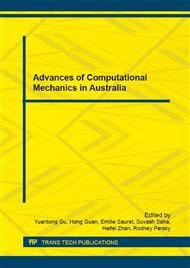[1]
F.P. Glasser, J. Marchand, E. Samson, Durability of concrete—degradation phenomena involving detrimental chemical reactions, Cem Concr Res. 38(2) (2008) 226-46.
DOI: 10.1016/j.cemconres.2007.09.015
Google Scholar
[2]
U. Angst, R. Hooton, J. Marchand, C. Page, R. Flatt, B. Elsener, et al., Present and future durability challenges for reinforced concrete structures, Mater Corros. 63(12) (2012) 1047-51.
DOI: 10.1002/maco.201206898
Google Scholar
[3]
A. Neville, The confused world of sulfate attack on concrete, Cem Concr Res. 34(8) (2004) 1275-96.
Google Scholar
[4]
E. Samson, J. Marchand, Modeling the transport of ions in unsaturated cement-based materials, Comput Struct. 85(23) (2007) 1740-56.
DOI: 10.1016/j.compstruc.2007.04.008
Google Scholar
[5]
J.J. Kaluarachchi, J. Morshed, Critical assessment of the operator-splitting technique in solving the advection-dispersion-reaction equation: 1. First-order reaction, Adv Water Resour. 18(2) (1995) 89-100.
DOI: 10.1016/0309-1708(95)00001-y
Google Scholar
[6]
K.T. MacQuarrie, K.U. Mayer, Reactive transport modeling in fractured rock: A state-of-the-science review, Earth-Sci Rev. 72(3) (2005) 189-227.
DOI: 10.1016/j.earscirev.2005.07.003
Google Scholar
[7]
E. Samson, J. Marchand, K. Snyder, J. Beaudoin, Modeling ion and fluid transport in unsaturated cement systems in isothermal conditions, Cem Concr Res. 35(1) (2005) 141-53.
DOI: 10.1016/j.cemconres.2004.07.016
Google Scholar
[8]
E. Samson, J. Marchand, Numerical solution of the extended Nernst–Planck model, J Colloid Interface Sci. 215(1) (1999) 1-8.
DOI: 10.1006/jcis.1999.6145
Google Scholar
[9]
E. Samson, G. Lemaire, J. Marchand, J. Beaudoin, Modeling chemical activity effects in strong ionic solutions, Comput Mater Sci. 15(3) (1999) 285-94.
DOI: 10.1016/s0927-0256(99)00017-8
Google Scholar
[10]
J. -F. Daian, Condensation and isothermal water transfer in cement mortar Part I—Pore size distribution, equilibrium water condensation and imbibition, Transport Porous Med. 3(6) (1988) 563-89.
DOI: 10.1007/bf00959103
Google Scholar
[11]
J. Mazars, G. Pijaudier-Cabot, Continuum damage theory-application to concrete, J ENG MECH. 115(2) (1989) 345-65.
DOI: 10.1061/(asce)0733-9399(1989)115:2(345)
Google Scholar
[12]
Y. Maltais, E. Samson, J. Marchand, Predicting the durability of Portland cement systems in aggressive environments—laboratory validation, Cem Concr Res. 34(9) (2004) 1579-89.
DOI: 10.1016/j.cemconres.2004.03.029
Google Scholar
[13]
S. Sarkar, S. Mahadevan, J. Meeussen, H. Van der Sloot, D. Kosson, Numerical simulation of cementitious materials degradation under external sulfate attack, Cem Concr Compos. 32(3) (2010) 241-52.
DOI: 10.1016/j.cemconcomp.2009.12.005
Google Scholar


